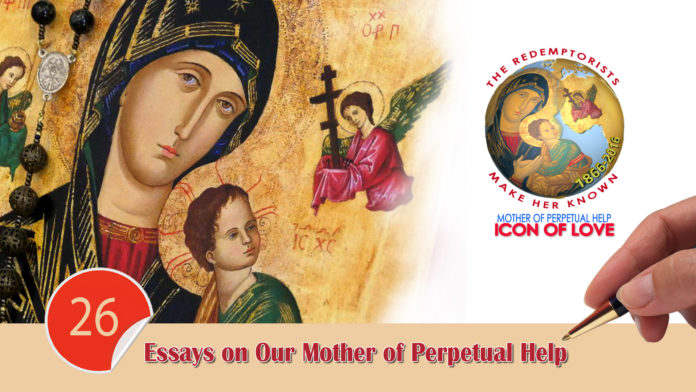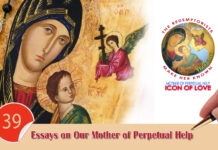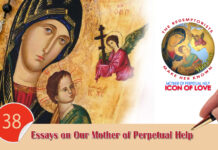The location of the Redemptorist Community of Clonard Monastery in the social and economic geography of Belfast has determined many of its apostolic choices since its foundation in 1896. Belfast is the only Irish city to bear, to any noticeable extent, the marks of the Industrial Revolution. Its wealth was founded on ship-building and production of linen. Its rapid economic expansion in the late nineteenth century meant that, for a short period, it threatened to outstrip Dublin as the largest city in the country.
Belfast has, for most of its life, been a religiously divided city. Catholics and Dissenters (members of reformed churches not belonging to the Anglican “established church”) found common cause in the late 18th century under the banner of the “United Irishmen.” In the course of the nineteenth century, relations between Catholics and Protestants became sharply polarized, often leading to inter-community riots (e.g. in 1829, 1843, 1857, 1864, 1872 and most seriously of all, 1886). Catholics had always been in a minority in Belfast, but the city’s growing industrialisation attracted many poor Catholics from rural Ulster, especially after the Famine of the 1840s. They settled, for the most part, in the west of the city, living in streets of small red-brick houses, and finding employment in linen mills where working conditions were unhealthy and wages low. Relatively few Catholics found their way into the better paying ship-building yards on the eastern side of the city. It was to West Belfast that the Redemptorists were directed when they applied to establish a community in the city, as the diocesan authorities hoped that their church would ease the strain on the four or five Catholic parishes on that side of the city.
West Belfast was a divided community. A largely Catholic community established itself around the main artery of the Falls Road: less than a mile away, a largely Protestant community formed itself around the Shankill Road. Clonard was situated between the two. Built on what had been part of the demesne of a Protestant mill-owner, a large part of the monastery garden was on land reclaimed from the pool of a linen mill. Relations between the two communities were often strained. A young brother in the community, Michael Morgan, was shot by mistake in 1922 in unrest brought on by the Irish War of Independence which led to the portioning of the country.
A Spiritual Harvest from a War
During the Second World War, the southern part of Ireland remained neutral. As part of Great Britain, Belfast was the first place in Europe where American troops landed in January 1942. A few months later, it experienced its first German bombing raids. Many of the people from the streets around Clonard, regardless of religion, took refuge in the monastery crypt. They sang hymns and prayed together – the first time they had ever done so with members of another faith.
At the end of that year, an American Redemptorist, Fr Matthew Meighan, who had come to Belfast as an army chaplain, was invited to preach in Clonard the novena in preparation for the feast of the Immaculate Conception. Fr Meighan had told the community of the new development in his home province, a weekly novena to Our Mother of Perpetual Help. He was encouraged to introduce it to his Clonard congregation. From the beginning, it was an extraordinary success. It brought hope and consolation in dark days. Some non-Catholics quietly attended the Clonard novena from the beginning, usually brought along by Catholic friends.
A few years later, Clonard made another imaginative apostolic outreach. Several Irish Redemptorists had served as chaplains in the British Army. One of them was the Belfast-born Daniel Cummings. He had been struck by how men, faced with a common danger and forced to live side by side, set aside ancient prejudices. Many of those serving in his Irish Guards regiment were Northern Ireland Protestants. He was the first priest most of them had ever encountered, yet he found a comradeship with them was based on shared memories and shared stories. He was appointed to Clonard after the war, and with the support and encouragement of his Rector, Fr Gerard Reynolds, he organised the first “Clonard Mission to Non-Catholics” in 1948. The title is somewhat unfortunate. The objective of the mission was not to convert Protestants, but to make a reasonable case for aspects of Catholicism many Protestants found objectionable. This was the beginning of what was to become the ecumenical ministry of Clonard. It continued annually until 1969, when a sharp turn in the political landscape forced its suspension.
Witnessing to Peace in a Time of Conflict
The religious divisions that had troubled Belfast for much of its history flared up with particular virulence in 1969. This time it was combined with a movement to claim civil rights for Nationalists (Catholics) in a society in which the economic and social structures were strongly weighted against them. What had been hoped would be a short-lived campaign to deliver equality, turned into a protracted period of social unrest, euphemistically called, with typically ironic Belfast humour, “The Troubles.”
After an attack on the Catholic community near Clonard in August 1969 during which many homes were burned down, and the monastery itself was threatened, a “Peace Line” was built to keep the two communities apart. It was intended to last for less than a year. More than forty years later, it is still there, and more than thirty kilometres of Peace Line exist in Belfast.
The story of the Clonard Community’s commitment to peace and justice from its place, quite literally on the Peace Line, is already well-known, especially through the work of the late Fr Al Reid. It is not my intention to summarise it here, except to point out that it has also been matched by a commitment to ecumenical dialogue at every level, spear-headed by Fr Gerry Reynolds. Clonard has become a place where Catholics and Protestants can meet both socially and at the level of theological dialogue. Each Sunday, some Clonard “Unity Pilgrims” assist at Mass and then cross the city to attend the service of another church. I will describe briefly in the remainder of this paper one particular event that brings that ecumenical dialogue to a larger audience and into fruitful contact with another of Clonard’s ministries, promotion of devotion to Our Lady of Perpetual Succour.
Protestants Preaching Mary?
Every year, the novena in preparation for the feast of Our Mother of Perpetual Help fills the church and the monastery corridors ten times a day. An Irish journalist has called it “a holy conveyor belt’ and underlines its appeal across all boundaries: “A smartly-dressed young woman sits next an old man in shabby cardigan, Filipino hospital staff, still in uniform, follow the hymns with difficulty. A couple in their 40s lean affectionately towards each other and joke in whispers” (Fionnula O’Connor, “Unifying Effects of a Novena” Irish Times, 16/6/206).
One of the barriers many novena goers cross is the denominational barrier. Some are drawn simply by curiosity at what attracts so many people to a religious service on a week-day. Others are brought by Catholic friends. Some come because the warm devotion they experience in Clonard to the Mother of the Lord finds little place in their own tradition.
Since 2002, the organisers of the novena have arranged that one day of the novena be set aside as ‘the Ecumenical Day.” Ministers from the Protestant tradition are invited to preach. Between 2002 and 2015, more than forty ministers have accepted the invitation. Several of them have been people of significance in their own churches (e.g. Anglican bishops, former moderators of the Presbyterian General Assembly or of the Methodist Conference). A goodly proportion of them have been women.
Although some extreme evangelical groups and writers of letters to newspapers have criticised the preachers for taking part in the novena, the response of novena goers has been highly positive and the visiting preachers are sometimes visibly moved by the warmth with which they are greeted by a Catholic congregation. One of the first was Rev Ken Newell, minister of a Presbyterian congregation in the University area of the city. His congregation included professional and university people, yet for some years, they had maintained a bond of fellowship with the largely working class congregation of Clonard, with both sides attending special events in each other’s church. When Rev Newell was preaching in 2002, He announced that he would preach about Jesus and his mother in the Gospels. While acknowledging that this was a subject that often led to disagreement between their respective Churches, he said he would emphasise what they had in common. The framework of his own sermon was that Mary’s treasure was her love for the Trinity. She listened to the Father’s voice; she listened to her Son’s teaching and she displayed a willingness to love people in obedience to the Spirit’s inspiration.
For some of the ministers, the invitation to preach in Clonard has been an invitation to rediscover the sometimes forgotten depths of their own tradition’s teaching about the Mother of Jesus. For the Catholic congregation who hear them, the ecumenical day at the novena has been an invitation to lay old attitudes aside and to rediscover a common biblical centred faith that places the Lord and his mother at the centre. For most Catholics, for example, it was probably news that the Anglican Church prays her Magnificat daily at Evensong, or celebrates as liturgical feasts her birthday, the Annunciation and Visitation. If the non-Anglican Churches have not retained the liturgical presence of Mary in their worship, John Calvin, the founder of what will eventually become the Presbyterian tradition could write: “To this day we cannot enjoy the blessing brought to us in Christ without thinking at the same time of that which God gave as adornment and honour to Mary, in willing her to be the mother of his only-begotten Son”. Or that John Wesley, founder of Methodism defended the perpetual virginity of Mary: “being conceived by the singular operation of the Holy Ghost, and born of the Blessed Virgin Mary, who, as well after as before she brought Him forth, continued a pure and unspotted virgin.”
Although it is the fruit of dialogue specifically between the Anglican Communion and the Roman Catholic Church, Mary: Grace and Hope in Christ. Seattle Statement of the Anglican-Roman Catholic International Commission (2004) may represent the way in which an honest coming together around the person of Mary can move the members of different churches forward in discovering new aspects of the larger mystery of the Church:
One outcome of our study has been awareness of differences in the ways in which the example of Mary living out the grace of God has been appropriated into the devotional lives of our traditions. Whilst both traditions have recognized her special place in the communion of saints, different emphases have marked the way we have experienced her ministry. (Preface by co-chairs)
Brendan McConvery CSsR
Province of Dublin







